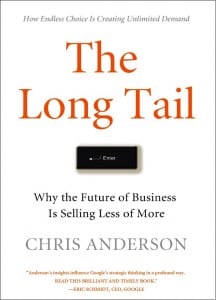Focusing on long tail keywords is a great SEO tactic. Long tail keywords are keywords or key phrases that are more specific – and usually longer – than more commonly searched for keywords. Long tail keywords get less search traffic, but will usually have a higher conversion value, as they are more specific. They allow you gradually to get more traffic and to be found by new and motivated audiences.
To really profit from a long tail keyword strategy, you should have a clear vision of your company, your product and your website. Here, I’ll explain what long tail keywords are and show you how understanding your own product helps you set up this strategy and why you should put effort in it.
What are long tail keywords?
Long tail keywords are more specific and less common than other keywords. They focus more on a niche. The term long tail keyword comes from the book The Long Tail by Chris Anderson (see aside). In this book, Chris Anderson shows there is a market for virtually every product. In some cases, however, this market is really, really, really small. The vastness of the internet, though, makes your niche product, or your niche blog post profitable.
One head theme
Most blogs have one main topic – this is called the head term, or main keyword. Mom blogs are usually about children and family life; food blogs are about eating, restaurants, and recipes. Our blog is all about SEO. We even named it SEO blog. So, all of our blog posts are about SEO, or about SEO-related-topics.
The main topic or theme of your blog or site is the number one keyword (or key phrase) you want people to use to find you. In our case SEO. Imagine yourself having a food blog about homemade Italian food. You would then like to be found on a search term like [homemade Italian food]. That would pretty much be the number one.
Lots of tail topics
You cannot, however, optimize all blog posts for the same term [homemade Italian food], even if all your blog posts will be about homemade Italian food. Instead, you should write a whole number of blog posts about all kinds of long tail variants of your number one search term. In the example of the food blog, you could write about all kind of delicious things: homemade Italian pasta, homemade Italian salads, homemade Italian pie. These could be your main categories.
Your blog posts could even be more long tail. You could write about: homemade Italian spaghetti bolognese, homemade Italian lasagna, homemade Italian penne carbonara and so on. You will find all of these keywords if you have done your keyword research correctly. If you come up with a lot of very long focus keywords, you can read my post about how to handle those here.
Link from the tail to the head!
If you optimize your blog post for different long tail variants, you should link from these blog posts to your more ‘head’ category pages and from these category pages to your most awesome pages: your cornerstone content. Remember: always link from the tail to your head! That way, you show Google what your site structure looks like and which of your pages is most important. Make sure your most amazing pages rank high in Google!
Why focus on long tail keywords?
It is much easier to rank for long tail keywords than for more common keywords, because fewer websites compete for high rankings in the result pages of Google. The longer (and more specific) search terms are, the easier it is to rank for the term. Because of the vastness of the internet, it is easier to find your audience for your particular niche. Focusing on a group of long tail keywords will result in a great deal of traffic altogether. Read on to find out how to choose keywords that’ll attract traffic.
Another benefit of focusing on long tail keywords is that, although these keywords are used less in search, the visitor that finds your website using them is more likely to buy your service or product.
I am currently looking for a cottage in France to spend our next summer vacation. I started my search with the term ‘vacation France’. After some searching, I quickly discovered I wanted to go to the Dordogne and preferred a house in the countryside. My search still continues, but now I use terms like [vacation house countryside Dordogne]. A long tail keyword. Using this keyword, I found new sites, which more closely resembled my vacation wishes. Chances for me to book my vacation largely increased.
So, why is your mission important?
If you want to sell something, you should simply have a damn good product! And you should be well aware of what your product or your website offers to your audience… what makes it special. If you know and understand this, it will be much easier to make your audience like and buy your stuff. You should thus take some time to think about the uniqueness of your product and write that down.
Perhaps you sell cruises to Hawaii. You offer great facilities for children, making the cruises especially suitable for young parents or single moms. Offering great cruises to Hawaii for single moms could be the uniqueness of your service. This is your mission, your niche, this is what you have to offer to your audience! Do make sure you write down your mission in words that are used and understood by your audience.
Read more: What is your mission »
Competitiveness of the market
In some markets, it is really hard to rank. Some markets are just highly competitive, with large companies dominating the search results. These companies have a very large budget to spend on marketing in general and SEO specifically. Ranking in these markets is hard. You will be unable to compete on a small budget in a market like the travel industry using search terms as Vacation Hawaii.
However, if you have your mission clear, you should be able to define what makes your product or website stand out from this market. You should be able to find your niche. And you should use YOUR mission in order to start ranking! Taking my example of cruises for single moms to Hawaii would mean that you should focus on the less competitive term [single mom cruises Hawaii]. Again, use words that are used by your target audience (and avoid difficult terms).
Use your mission to define long tail keywords
The definition of your mission, in which you make crystal clear what the awesomeness of your product, site or blog is, should be central in choosing the long tail keywords you want to rank for. Trying to make your website rank for a specific term can be quite profitable, as long as this specific term closely resembles the product you’re selling.
The terms you have used to describe your mission can be nicely used to focus on in your SEO strategy. These words should be central in the long tail keywords you aim your website to rank for. People using the terms of your mission and finding your website will be relatively small in volume, but these people do have the highest chances to buy your product or to become regular visitors.
The next step: awesome content
After you have done your keyword research and you know which keywords you would like to rank for, you’ll have to start creating content. Creating content can be quite challenging. Read all about creating quality content in SEO copywriting: the ultimate guide.
Want to learn how to do this for your own site? You should check our interactive SEO copywriting course!
Keep reading: Keyword research: the ultimate guide »

